Analysis of the Opioid and Heroin Crisis: Strategies and Actions
VerifiedAdded on 2020/12/29
|8
|820
|278
Report
AI Summary
This report addresses the prescription opioid and heroin crisis, highlighting the alarming increase in opioid use and its devastating consequences, including overdose deaths and neonatal withdrawal syndrome. It details actions taken by the healthcare industry, such as stricter opioid prescribing practices and increased access to addiction treatment, supported by the Health and Human Services (HHS). The report outlines strategies proposed by the Healthcare Information Management and Systems Society (HIMSS), including leveraging prescription drug monitoring programs (PDMPs), training healthcare workers, and utilizing interoperable electronic health data. These strategies aim to track prescriptions, prevent drug interactions, and facilitate better patient care across various healthcare disciplines. The report emphasizes the importance of secure data sharing and a comprehensive approach to address the crisis effectively.
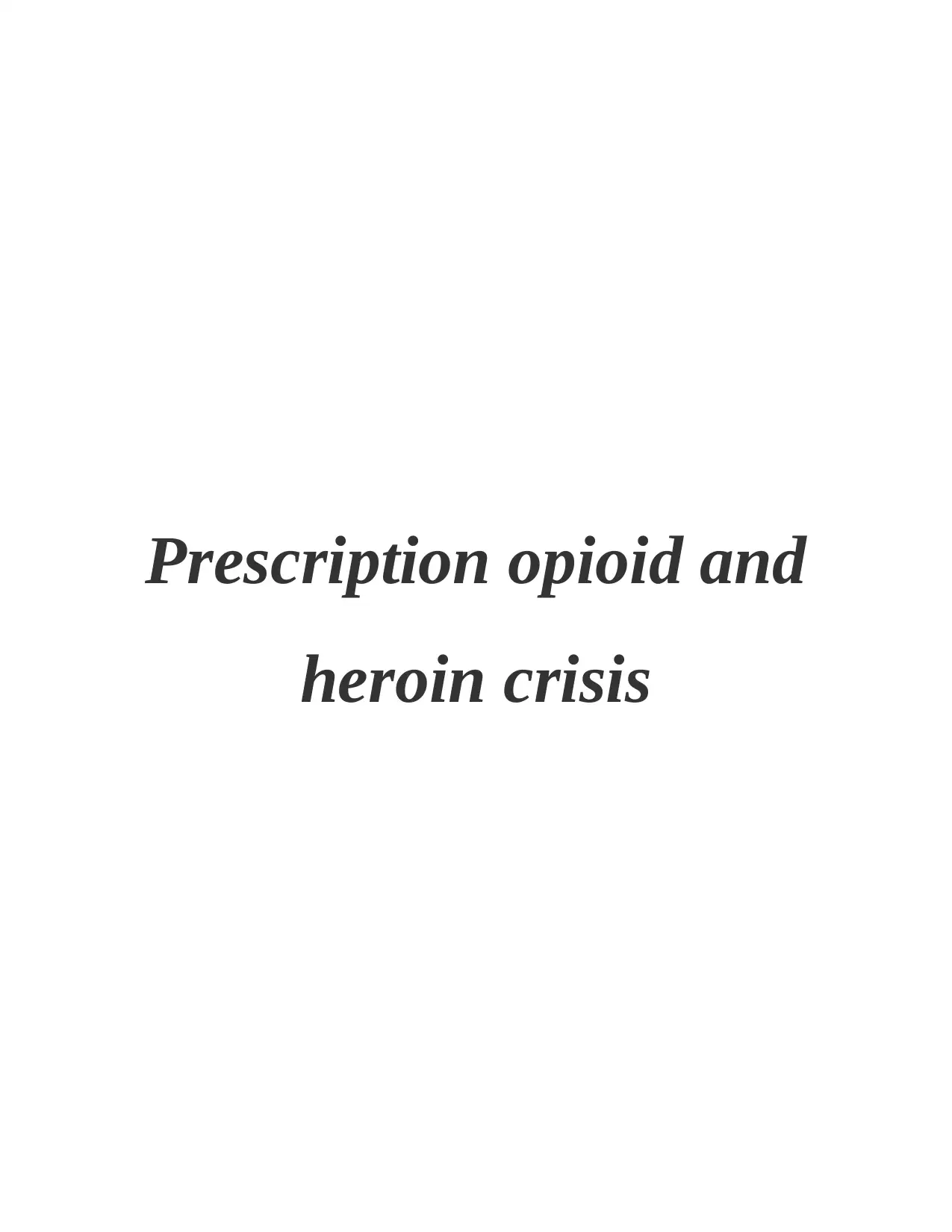
Prescription opioid and
heroin crisis
heroin crisis
Paraphrase This Document
Need a fresh take? Get an instant paraphrase of this document with our AI Paraphraser
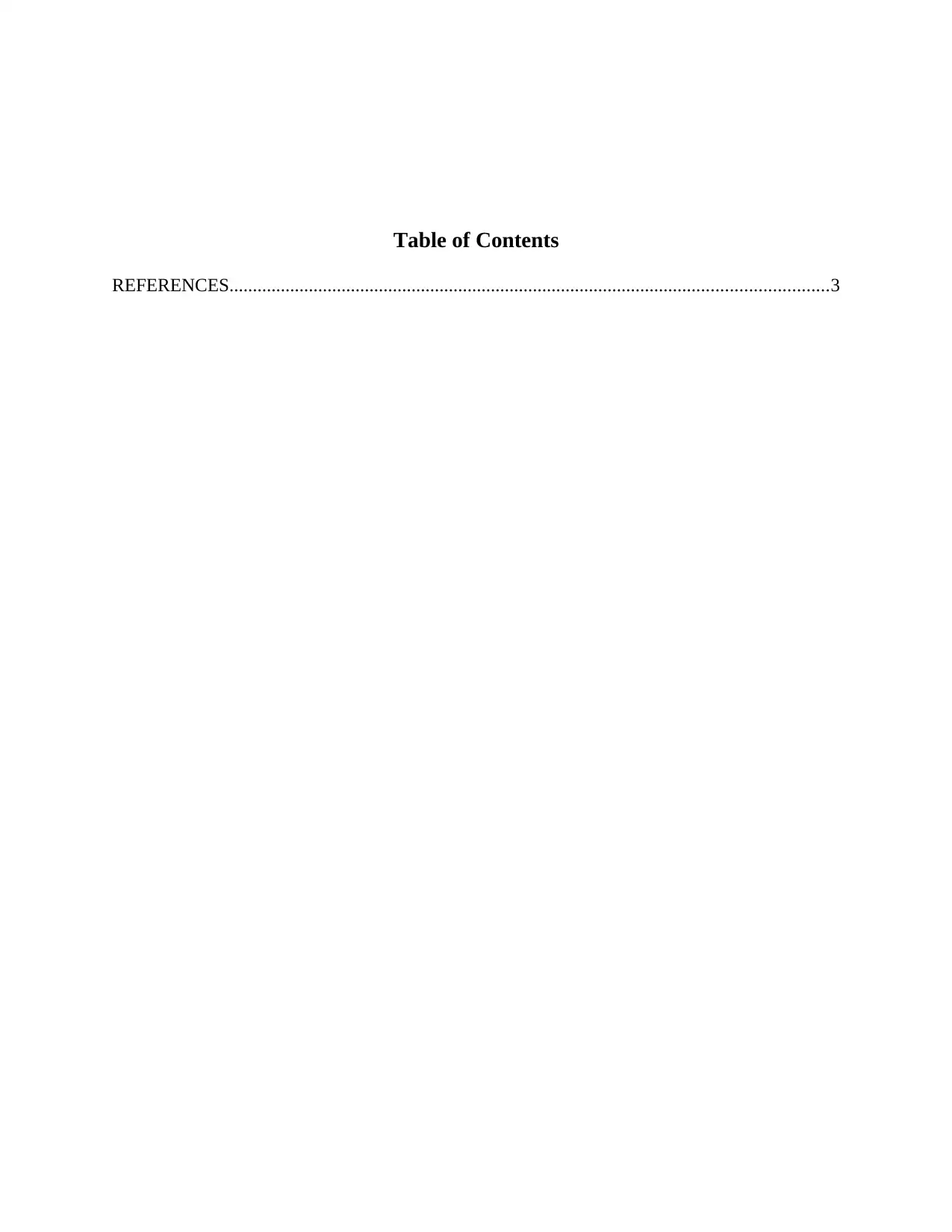
Table of Contents
REFERENCES................................................................................................................................3
REFERENCES................................................................................................................................3

⊘ This is a preview!⊘
Do you want full access?
Subscribe today to unlock all pages.

Trusted by 1+ million students worldwide

Paraphrase This Document
Need a fresh take? Get an instant paraphrase of this document with our AI Paraphraser
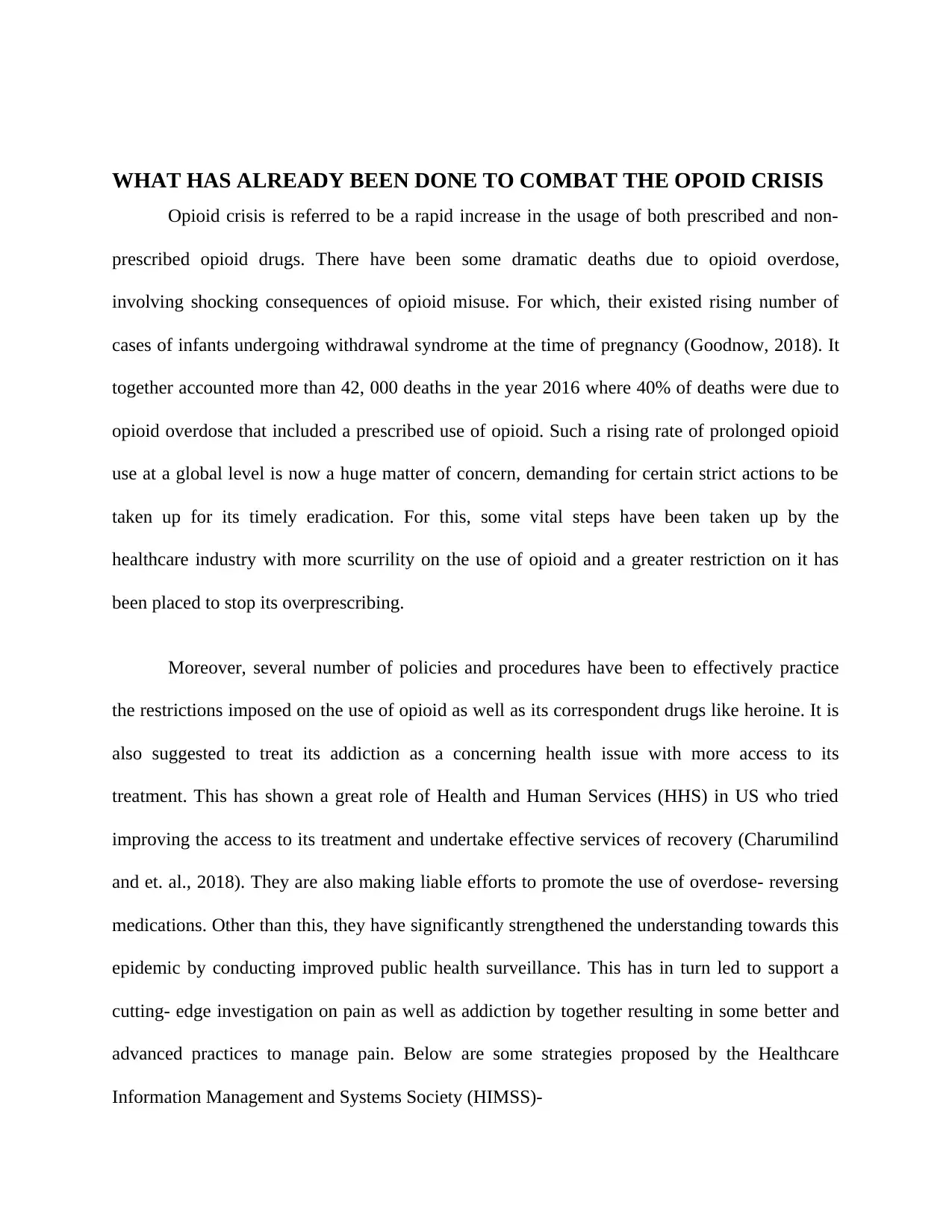
WHAT HAS ALREADY BEEN DONE TO COMBAT THE OPOID CRISIS
Opioid crisis is referred to be a rapid increase in the usage of both prescribed and non-
prescribed opioid drugs. There have been some dramatic deaths due to opioid overdose,
involving shocking consequences of opioid misuse. For which, their existed rising number of
cases of infants undergoing withdrawal syndrome at the time of pregnancy (Goodnow, 2018). It
together accounted more than 42, 000 deaths in the year 2016 where 40% of deaths were due to
opioid overdose that included a prescribed use of opioid. Such a rising rate of prolonged opioid
use at a global level is now a huge matter of concern, demanding for certain strict actions to be
taken up for its timely eradication. For this, some vital steps have been taken up by the
healthcare industry with more scurrility on the use of opioid and a greater restriction on it has
been placed to stop its overprescribing.
Moreover, several number of policies and procedures have been to effectively practice
the restrictions imposed on the use of opioid as well as its correspondent drugs like heroine. It is
also suggested to treat its addiction as a concerning health issue with more access to its
treatment. This has shown a great role of Health and Human Services (HHS) in US who tried
improving the access to its treatment and undertake effective services of recovery (Charumilind
and et. al., 2018). They are also making liable efforts to promote the use of overdose- reversing
medications. Other than this, they have significantly strengthened the understanding towards this
epidemic by conducting improved public health surveillance. This has in turn led to support a
cutting- edge investigation on pain as well as addiction by together resulting in some better and
advanced practices to manage pain. Below are some strategies proposed by the Healthcare
Information Management and Systems Society (HIMSS)-
Opioid crisis is referred to be a rapid increase in the usage of both prescribed and non-
prescribed opioid drugs. There have been some dramatic deaths due to opioid overdose,
involving shocking consequences of opioid misuse. For which, their existed rising number of
cases of infants undergoing withdrawal syndrome at the time of pregnancy (Goodnow, 2018). It
together accounted more than 42, 000 deaths in the year 2016 where 40% of deaths were due to
opioid overdose that included a prescribed use of opioid. Such a rising rate of prolonged opioid
use at a global level is now a huge matter of concern, demanding for certain strict actions to be
taken up for its timely eradication. For this, some vital steps have been taken up by the
healthcare industry with more scurrility on the use of opioid and a greater restriction on it has
been placed to stop its overprescribing.
Moreover, several number of policies and procedures have been to effectively practice
the restrictions imposed on the use of opioid as well as its correspondent drugs like heroine. It is
also suggested to treat its addiction as a concerning health issue with more access to its
treatment. This has shown a great role of Health and Human Services (HHS) in US who tried
improving the access to its treatment and undertake effective services of recovery (Charumilind
and et. al., 2018). They are also making liable efforts to promote the use of overdose- reversing
medications. Other than this, they have significantly strengthened the understanding towards this
epidemic by conducting improved public health surveillance. This has in turn led to support a
cutting- edge investigation on pain as well as addiction by together resulting in some better and
advanced practices to manage pain. Below are some strategies proposed by the Healthcare
Information Management and Systems Society (HIMSS)-
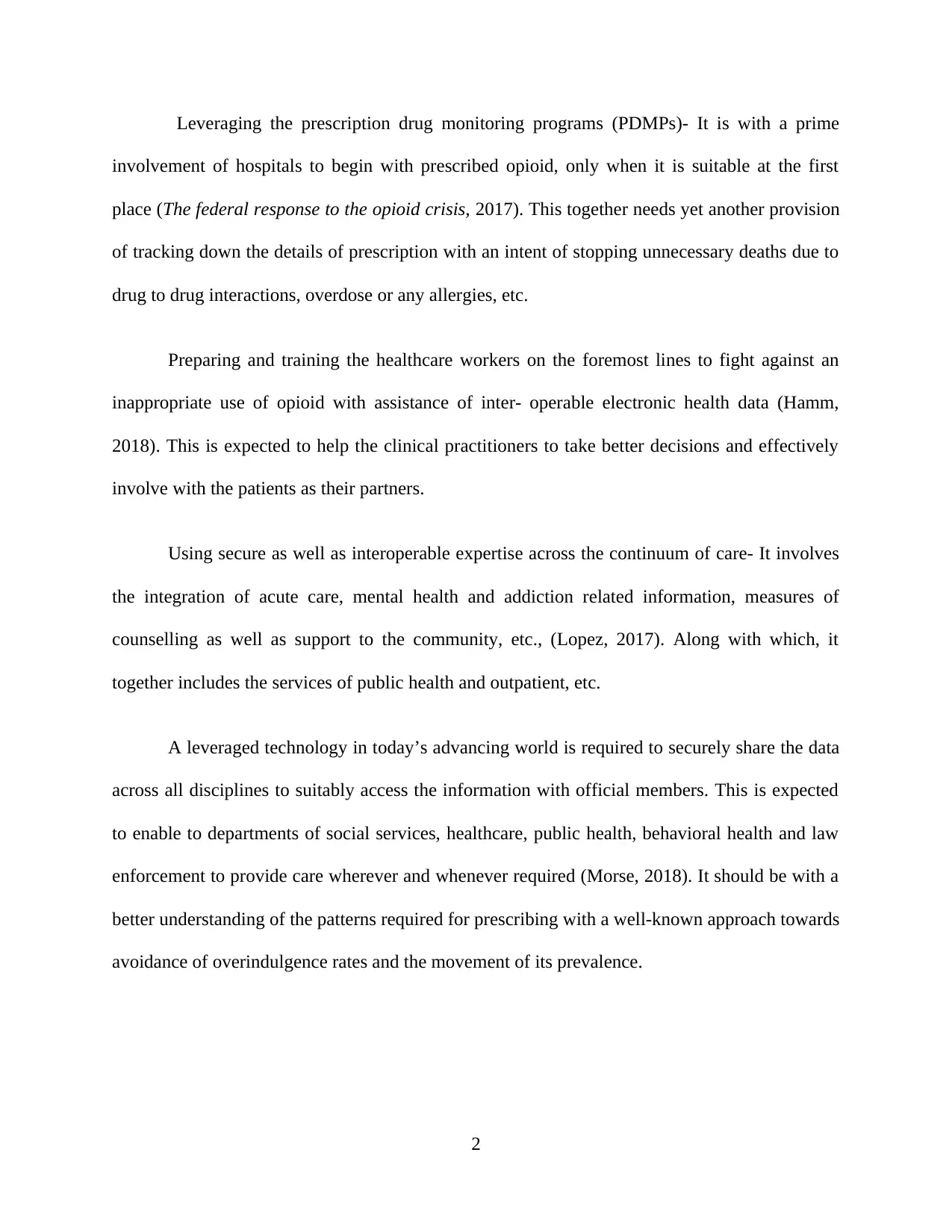
Leveraging the prescription drug monitoring programs (PDMPs)- It is with a prime
involvement of hospitals to begin with prescribed opioid, only when it is suitable at the first
place (The federal response to the opioid crisis, 2017). This together needs yet another provision
of tracking down the details of prescription with an intent of stopping unnecessary deaths due to
drug to drug interactions, overdose or any allergies, etc.
Preparing and training the healthcare workers on the foremost lines to fight against an
inappropriate use of opioid with assistance of inter- operable electronic health data (Hamm,
2018). This is expected to help the clinical practitioners to take better decisions and effectively
involve with the patients as their partners.
Using secure as well as interoperable expertise across the continuum of care- It involves
the integration of acute care, mental health and addiction related information, measures of
counselling as well as support to the community, etc., (Lopez, 2017). Along with which, it
together includes the services of public health and outpatient, etc.
A leveraged technology in today’s advancing world is required to securely share the data
across all disciplines to suitably access the information with official members. This is expected
to enable to departments of social services, healthcare, public health, behavioral health and law
enforcement to provide care wherever and whenever required (Morse, 2018). It should be with a
better understanding of the patterns required for prescribing with a well-known approach towards
avoidance of overindulgence rates and the movement of its prevalence.
2
involvement of hospitals to begin with prescribed opioid, only when it is suitable at the first
place (The federal response to the opioid crisis, 2017). This together needs yet another provision
of tracking down the details of prescription with an intent of stopping unnecessary deaths due to
drug to drug interactions, overdose or any allergies, etc.
Preparing and training the healthcare workers on the foremost lines to fight against an
inappropriate use of opioid with assistance of inter- operable electronic health data (Hamm,
2018). This is expected to help the clinical practitioners to take better decisions and effectively
involve with the patients as their partners.
Using secure as well as interoperable expertise across the continuum of care- It involves
the integration of acute care, mental health and addiction related information, measures of
counselling as well as support to the community, etc., (Lopez, 2017). Along with which, it
together includes the services of public health and outpatient, etc.
A leveraged technology in today’s advancing world is required to securely share the data
across all disciplines to suitably access the information with official members. This is expected
to enable to departments of social services, healthcare, public health, behavioral health and law
enforcement to provide care wherever and whenever required (Morse, 2018). It should be with a
better understanding of the patterns required for prescribing with a well-known approach towards
avoidance of overindulgence rates and the movement of its prevalence.
2
⊘ This is a preview!⊘
Do you want full access?
Subscribe today to unlock all pages.

Trusted by 1+ million students worldwide
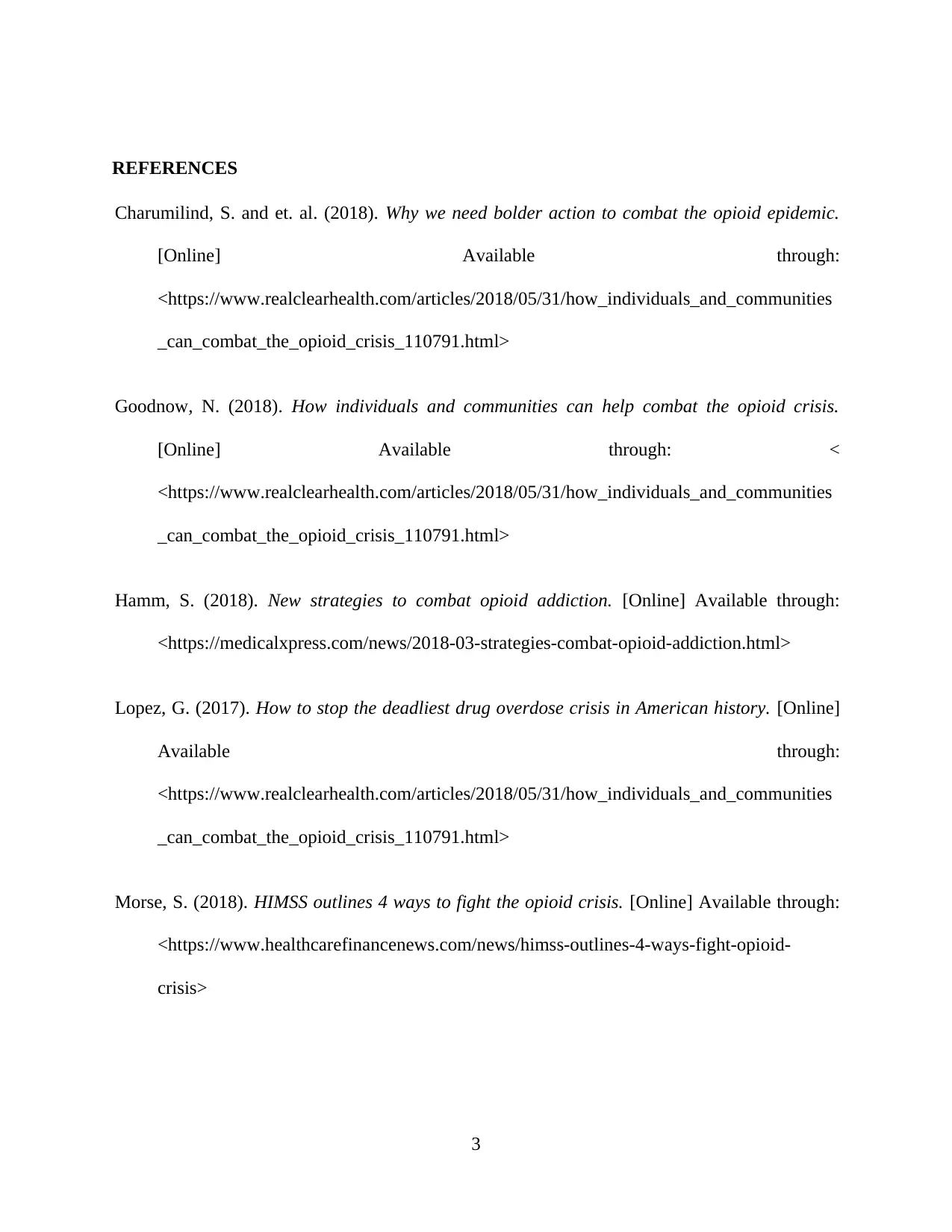
REFERENCES
Charumilind, S. and et. al. (2018). Why we need bolder action to combat the opioid epidemic.
[Online] Available through:
<https://www.realclearhealth.com/articles/2018/05/31/how_individuals_and_communities
_can_combat_the_opioid_crisis_110791.html>
Goodnow, N. (2018). How individuals and communities can help combat the opioid crisis.
[Online] Available through: <
<https://www.realclearhealth.com/articles/2018/05/31/how_individuals_and_communities
_can_combat_the_opioid_crisis_110791.html>
Hamm, S. (2018). New strategies to combat opioid addiction. [Online] Available through:
<https://medicalxpress.com/news/2018-03-strategies-combat-opioid-addiction.html>
Lopez, G. (2017). How to stop the deadliest drug overdose crisis in American history. [Online]
Available through:
<https://www.realclearhealth.com/articles/2018/05/31/how_individuals_and_communities
_can_combat_the_opioid_crisis_110791.html>
Morse, S. (2018). HIMSS outlines 4 ways to fight the opioid crisis. [Online] Available through:
<https://www.healthcarefinancenews.com/news/himss-outlines-4-ways-fight-opioid-
crisis>
3
Charumilind, S. and et. al. (2018). Why we need bolder action to combat the opioid epidemic.
[Online] Available through:
<https://www.realclearhealth.com/articles/2018/05/31/how_individuals_and_communities
_can_combat_the_opioid_crisis_110791.html>
Goodnow, N. (2018). How individuals and communities can help combat the opioid crisis.
[Online] Available through: <
<https://www.realclearhealth.com/articles/2018/05/31/how_individuals_and_communities
_can_combat_the_opioid_crisis_110791.html>
Hamm, S. (2018). New strategies to combat opioid addiction. [Online] Available through:
<https://medicalxpress.com/news/2018-03-strategies-combat-opioid-addiction.html>
Lopez, G. (2017). How to stop the deadliest drug overdose crisis in American history. [Online]
Available through:
<https://www.realclearhealth.com/articles/2018/05/31/how_individuals_and_communities
_can_combat_the_opioid_crisis_110791.html>
Morse, S. (2018). HIMSS outlines 4 ways to fight the opioid crisis. [Online] Available through:
<https://www.healthcarefinancenews.com/news/himss-outlines-4-ways-fight-opioid-
crisis>
3
Paraphrase This Document
Need a fresh take? Get an instant paraphrase of this document with our AI Paraphraser
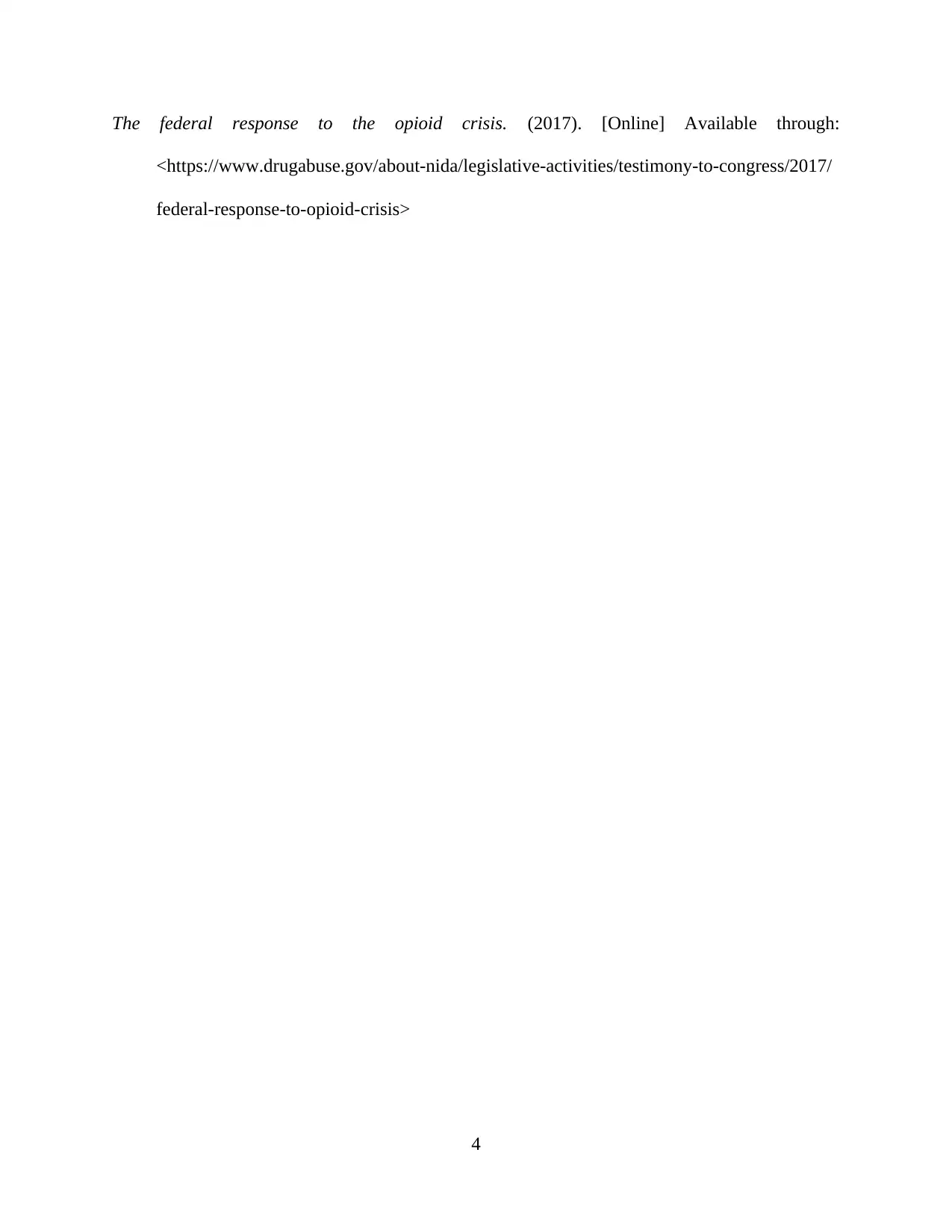
The federal response to the opioid crisis. (2017). [Online] Available through:
<https://www.drugabuse.gov/about-nida/legislative-activities/testimony-to-congress/2017/
federal-response-to-opioid-crisis>
4
<https://www.drugabuse.gov/about-nida/legislative-activities/testimony-to-congress/2017/
federal-response-to-opioid-crisis>
4
1 out of 8
Related Documents
Your All-in-One AI-Powered Toolkit for Academic Success.
+13062052269
info@desklib.com
Available 24*7 on WhatsApp / Email
![[object Object]](/_next/static/media/star-bottom.7253800d.svg)
Unlock your academic potential
Copyright © 2020–2025 A2Z Services. All Rights Reserved. Developed and managed by ZUCOL.





